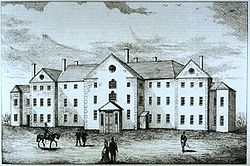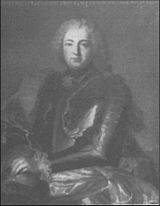|
Military of New France

The military of New France consisted of a mix of regular forces from the French Royal Army (Carignan-Salières Regiment) and French Navy (Troupes de la marine, later Compagnies Franches de la Marine) supported by small local volunteer militia units (Colonial militia).[1] Most early troops were sent from France, but localization after the growth of the colony meant that, by the 1690s, many were volunteers from the settlers of New France, and by the 1750s most troops were descendants of the original French inhabitants.[2] Additionally, many of the early troops and officers who were born in France remained in the colony after their service ended, contributing to generational service and a military elite.[3] The French built a series of forts from Newfoundland to Louisiana during the 1600s to the late 1700s.[4] Some were a mix of military posts and trading forts.[4] Military strategyThe soldiers of New France were either exceptionally well trained and very apt to the challenges of the colonial frontier, or they were dangerously inept.[5] Most of the military consisted of habitant militia rather than actual French soldiers.[6] Upon their arrival, the soldiers of New France learned quickly that the traditional military techniques seen on the battlefields of Europe were not at all effective in the New World. The Iroquois attacks on the French forced them to adapt to their current situation. Luckily the French were experts on forging alliances with the Native people and with the help from their allies the French adopted what they called "la petite guerre".[7] This was essentially small-scale guerrilla warfare that allowed the French to harass and cripple targets slowly over time rather than engage in battle after battle, something that New France could not afford. The strategy consisted mostly of stealth and surprise attacks whose purpose lay in creating ambushes and raids, followed by immediate withdrawals from the battlefield. This strategy focused on the elimination of small groups of targets rather than capturing targets of strategic value.[7] This style of warfare was not only well suited to the North American wilderness but it also allowed the French troops to be at a vast numerical disadvantage (outnumbered sometimes 20 to 1) and still effectively retaliate against their enemies, primarily the British.[8] Ironically, the fact that most of the soldiers were in fact habitant militia men actually aided in the ability to fight using these strategies given that many of these men would have been hunters and would already be accustomed to hunting and stalking in forests. Indigenous relationsIndigenous alliesIt was the job of the military to maintain good relations with frontier Indigenous North Americans in order to preserve French interests in the colony. In fact, preserving a positive relationship between the French and Native Peoples was the most important of the duties that were given to the military.[9] Throughout the years the French developed ties with several Native tribes, those allies consisted mainly of the Abenakis, Algonquin, Huron, Montagnais, and Outaouais[7] and through their partnership they taught the French much more than just military strategy. They taught them how to hunt, fish and dress their catches and they taught them how to navigate and essentially survive in the unforgiving Canadian wilderness. The French soldiers relied heavily on the Native warriors but their allegiance came at a cost. The Natives were "self interested and attached themselves only to the one who gives them the most… and if they failed to be rewarded one single time, the good that was done for them before counts for nothing".[10] In addition, the Natives as tribes provided knowledge of the wilderness but the tribes themselves were not active in their wars as a whole. Native warriors participated in the French battles if they chose to do so usually under the arrangement that they would be compensated for their participation. Falling short on these agreements sometimes caused great discourse amongst the Natives and sometimes damaged French-Native relationships. Decadence amongst the soldiersPart of the job of the military was to create good trade relations with the Natives. New France relied heavily on the fur trade given that it was the only valuable commodity in the entire colony, which cost more to operate than it brought in, in profit.[11] However, much of the military hierarchy was not based on merit but rather on internal family connections, which allowed unqualified young ambitious and greedy men to take positions of high rank. This resulted in many soldiers leaving their post for weeks at a time in order to illegally trade with the Natives. The Natives had an understanding of how the trading system worked and considered the military as "trading-goods chiefs"[12] and because of their dereliction of duty came to recognize many soldiers as dishonest people who went against their code. In addition there were even times where the presents the king would send to keep friendly relations with the Natives were often taken and sold to them for profit instead, the only presents they would give them would be mere trinkets.[12] Therefore, the lack of discipline amongst some of the higher ups resulted in losing face amidst the natives and subsequently losing some of their business and their allegiance to the English. Installations The French and Canadiens built forts from Newfoundland to Louisiana and others captured from the British from the 1600s to the late 1700s. Some were a mix of military post and trading forts.




Units  
Military commanders
French Royal Navy

Ships built in New FranceA list of ships posted to New France:
Ship building in New France 1650s and repair facilities were available in Quebec and Louisburg. Ships built in Quebec shipyard include:
Weapons
See also
References
|
